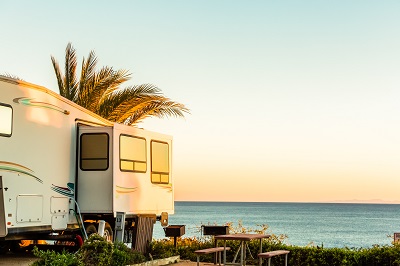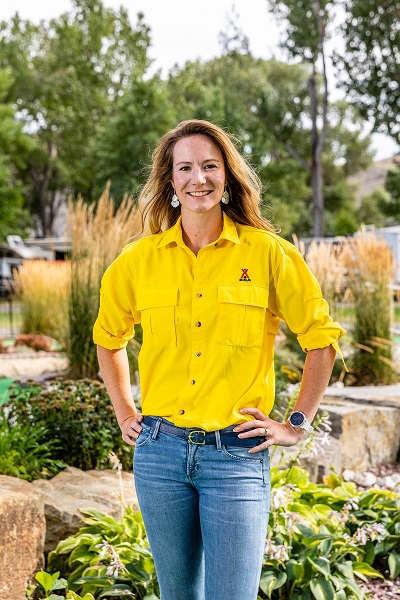
Kampgrounds of America (KOA) recently released its 57-page 2023 North American Camping and Outdoor Hospitality Report. The report offers several key insights for RV industry businesses.
Glamping as a Gateway
The report revealed 32% of all leisure trips taken were by campers or glampers. Glamping is a term meaning “glamorous camping,” KOA said, featuring an extra comfort level offering a luxury outdoor experience.
Ten million households took a glamping trip in 2022, according to the report, an increase of 3 million households since 2020.
In 2021, 26% of households surveyed were interested in glamping. In 2023, 38% of those surveyed expressed an interest in it.
According to KOA SVP of Strategy Whitney Scott, the industry’s glamping sector is stealthily introducing leisure travelers to the camping world.
“What we have seen is we have not lost some of those people,” Scott said. “They are continuing to either try glamping or are now starting to try other forms of camping because they recognize some of those benefits in camping.”
Scott said RVs are used in a specific subset of the glamping sector. Campers will rent an RV and go luxury camping instead of camping in a tent as they might have in years past.
Glampers typically want to stay away from public facilities, Scott said, and use the outdoors to disconnect from the daily grind. They want access to services and to savor unique experiences. A majority (63%) want an experience that blends the benefits of staying at a resort and the outdoors, the report said.
The report said that glampers usually have children, are likely to be millennials (58%), and tend to be more affluent. Most glampers surveyed have an income of $100,000 or more.

Services and amenities beyond simply providing a campsite are termed outdoor hospitality by the report. Outdoor hospitality is becoming more important to younger campers, the report said. Half of leisure travelers and 78% of active campers surveyed said outdoor hospitality factors into their trip-planning processes.
If money were no issue, Scott said, half of the tent campers would migrate to RVs (22%) or cabins (27%).
Once campers get into glamping, Scott said, if they like it enough, they may say, “I want this for my life and I am going to purchase an RV.”
Crossover is Important
The report found a preference for all travel types and camping are highly correlated.
Of those surveyed, 38% want to try glamping for the first time in 2023.
RVing qualifies as an adventure for those surveyed. Twenty-nine percent of consumers who camp want to try RVing for the first time in 2023 and 20% want to try full-time RVing.
Scott said the trend is exciting for RV-oriented campgrounds that host full-time RVers.
In 2023, consumers said they want to travel for natural events (40%) and food tourism and culinary experiences (36%).
More Trips per Year
The report discovered those surveyed are camping three times per year instead of one time per year as in years past. The return is something not seen from the most aggressive of investments, Scott said.
“That is 174% growth in the past 10 years,” Scott said. “That is amazing. It points to how important camping has become to connect with nature as a population, not just as a sector.”
According to Scott, camping used to be a traveler’s focus or main activity. A new generation of consumers who camp are choosing an activity, such as touring a vineyard, then deciding camping will help them experience that activity at a deeper level or with more convenience.
RVers are Dedicated and Resilient
According to the report, RV owners are the most avid consumers who camp.
RVers want to use their RVs once they have made an investment, Scott said.
The economy is playing a role in RV use, she said.
“If you already own an RV…” she said, “it is a way to travel without some of those large added costs that we are seeing in airfare, hotels and cruises.”
More than half (56%) of RVers plan to use their RV more or the same amount in the face of an economic downturn, the report said, pointing to the resiliency of the activity.
Most RVers (80%) plan to make some change to their RV, the report said. One fourth are planning to upgrade their RV. Only 6% are planning to sell their RV and not purchase another RV, the report said.
According to the report, 15 million households went RVing over the past year, including 12 million RV owners.
“RVing is a very healthy thing in the economy, that is putting money back into our communities,” Scott said. “That is a really important message for our industry to understand. $52 billion was spent in communities by campers and they actually intend to spend more this year and if the economy worsens. There is a healthy amount of people that will continue or increase their campaign behavior.”
 Accessibility Needs Surfacing
Accessibility Needs Surfacing
According to Scott, the KOA report team instituted a corporate responsibility focus for 2023. As a result of the initiative, the organization began collecting data about accessibility issues. For the first time, the report found 4 in 10 consumers who camp have mobility issues. Consumers have difficulty climbing stairs or walking, the report said.
Physical impairments extend beyond wheelchair access, Scott said, to vision impairment issues and social impairment.
Campgrounds are starting to incorporate quieter areas for individuals who get overstimulated by noise or harsh lighting, for example.
“I think we have not recognized how every single piece of the RV industry has a responsibility to reimagine or redefine what they are providing,” Scott said. “To really create more access and more business for people with physical impairments.”
For manufacturers, she said, that includes reimagining what an “acceptable RV looks like.”
Hush Camping
Some consumers who camp are taking camping trips with their families and working remotely from a campground during the day and vacationing with their family at night. This new trend has been dubbed “hush camping.”
“It is about the ability to create a way to work a full day and be productive,” Scott said, “and vacation during their free time that day… We want to support that and make sure that message is around the balance of work and play that can happen during a regular day.”
Many Canadians followed this trend last year. According to the report, lifting pandemic restrictions resulted in half a million new Canadian households camping in 2022. Fifty percent of those new consumers who camp said they worked during their camping trips—twice as many who worked while camping in 2021. For this reason, Wi-Fi amenities became a significant part of trip planning, the report said.




